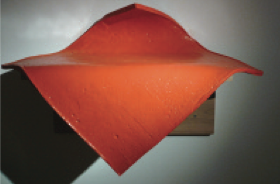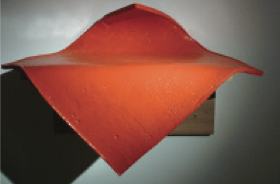Eduardo Costa
Ideobox Art Space Miami
Ideobox Art Space has brought to Miami a retrospective exhibition of the work of Eduardo Costa (Buenos Aires, 1940) which, under the title “Mid Career Survey - Fashion Fictions, Names of Friends, & The Painting/ Object”, offers the viewer a summary vision of the prolific artistic production of the past forty years of this important and sui generis Argentine conceptualist. Costa embraced conceptual art in the late 1960s, together with that group of pioneers that included Dan Graham, Vito Acconci, Marjorie Strider and others. His work, however, has differentiared itself markedly from US conceptualism, so literal, cerebral and structured as the Anglo-Saxon character itself, and he has always preferred a more disorderly, sensory and playful approach, permeated by humor and iconographic passion. Perhaps for this reason one may feel he is closer to Duchamp than to Kosuth, and not precisely on account of his reincarnation of the Escultura con porción de bicicleta (The Duchamp- Costa Bicycle), but because of that attitude of “working with what there is” described by the legendary curator Walter Hopps, recalling the first exhibition of the artist’s work presented in a US museum, the Pasadena Museum. This came to my mind when I learned about the casual way in which Costa began to produce his “volumetric paintings” after inadvertently leaving a jar of acrylic paint open; the paint hardened and adopted the shape of the container, just like a plaster cast.

But the exhibit does not only include numerous examples of the various concepts that his volumetric paintings have explored, in their multiple layers of humor, since he began to produce the series in 1994. It features Inclusive White Painting, described in its tech- nical specifications as acrylic on and around canvas − which implies that the paint does not only cover the front of the canvas but also its back −; there are also paintings transformed into soft sculptures, like that Soft Orange Painting with the appearance of a flying carpet, and others so aparently rigid as the great wedge of yellow paint that could seemingly immobilize a truck’s wheels. Other works which are specifically sculptures humorously parody decorative polychrome sculpture, mortuary masks and even George Segal himself, portraying fruits and vegetables, furniture and friends. The show also includes works from more classic periods, like the Fashion Fictions, his series of “media interventions” published between 1966 and 1984 in Vogue, Harper’s Bazaar and The New York Times Magazine − works which might perfectly have inspired Marilyn Minter’s fashion victims.
The video La lección de anatomía (didactic performance) accompanies the Portrait of the Poet Carter Ratcliff, in which the artist reveals to a surprised audience what some of his volumetric paintings contain, adding another layer of humor and another semantic level to his aesthetic divertimento: the hard-boiled eggs contain their yolks; the watermelon contains its red pulp, and the poet’s skull contains his brain, posing the doubt as to whether all the figurative works might contain this careful reconstruction in their interior.




